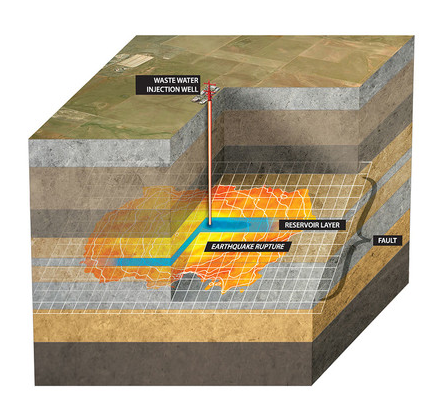Modeling the Effects of Wastewater Injection
Published on by Water Network Research, Official research team of The Water Network in Academic
Earth scientists develop a model to estimate the largest possible quake in a given location that could be caused by the disposal of water used in hydraulic fracturing
Written by Robert Perkins

Wastewater injected in an underground reservoir layer crossed by a fault triggers an earthquake. The earthquake rupture grows larger than the zone pressurized by water injection. Credit: Galis et al., and Thomas Willard/Caltech Graphic Resources
In work that offers insight into the magnitude of the hazards posed by earthquake faults in general, seismologists have developed a model to determine the size of an earthquake that could be triggered by the underground injection of fluids produced as a by-product of hydraulic fracturing.
Hydraulic fracturing, or "fracking," is a petroleum-extraction procedure in which millions of gallons of water (as well as sand and chemicals) are injected deep into underground shale beds to crack the rock and release natural gas and oil.
According to the United States Geological Survey, fracking itself does not typically trigger earthquakes. Instead, the increased risk for seismicity is more strongly linked with the subsequent injection of the wastewater from fracking and other oil-extraction processes into massive disposal wells that are thousands of feet underground.
Previous attempts to model the relationship between injection of wastewater and the triggering of earthquakes suggested that the maximum magnitude of the seismic activity induced in this way would be proportional to the volume of the fluids injected. However, this interpretation fails to account for the fact that earthquakes can grow beyond the area impacted by fluid pressure, says Jean Paul Ampuero, professor of seismology at Caltech and co-author of a new study on the topic that appears in the journal Science Advances on December 20.
Combining theory and computer simulations of dynamic earthquake ruptures, Ampuero and his colleagues developed a model that explains how the size of injection-induced earthquakes depends on not only the volume of fluid being injected but also the energy stored on nearby faults. The result is a model that quantifies the distance that an earthquake can propagate beyond an injection site—which in turn predicts the maximum magnitude of an induced seismic event.
"Earthquakes induced by human activities involving underground injection of fluids or gas are a growing concern, a hazard that needs to be controlled in order to develop a safer and cleaner energy future," Ampuero says.
This induced seismicity has been the subject of significant research in recent years and is also attracting researchers who, like Ampuero, are primarily interested in unraveling the physics of natural earthquakes. "This may be the closest researchers will ever get to a large-scale controlled earthquake experiment," Ampuero says. For the new work, Ampuero teamed up with Martin Galis, postdoctoral researcher at King Abdullah University of Science and Technology (KAUST) in Saudi Arabia.
It is important to note that the new model only predicts the maximum possible magnitude of an earthquake rather than what the earthquake magnitude will actually be, the researchers say. It defines upper limits based on the amount of pent-up energy in the earth's crust prior to fluid injection.
The new model offers insight into natural earthquakes, creating a framework for understanding what causes earthquakes to stop shaking. Earthquakes can be triggered by the pressure and disturbance caused by fluid injection, but they may grow beyond the zone immediately impacted by the wastewater injection by tapping into tectonic energy that is already stored nearby. As is the case for induced seismicity, natural earthquakes can start in small areas of the earth's crust where that energy is concentrated. How large they grow is determined by the amount of energy in surrounding regions.
Read full article: Caltech
Media
Taxonomy
- Groundwater
- Fracking
- Well Drilling
- Groundwater Modeling
- Groundwater Pollution
- Oil Field Chemicals
- Fracking Technology
- Oil & Gas